Introducing a very easy and foolproof way to season your new carbon steel pan, so it will become nonstick and last a lifetime.
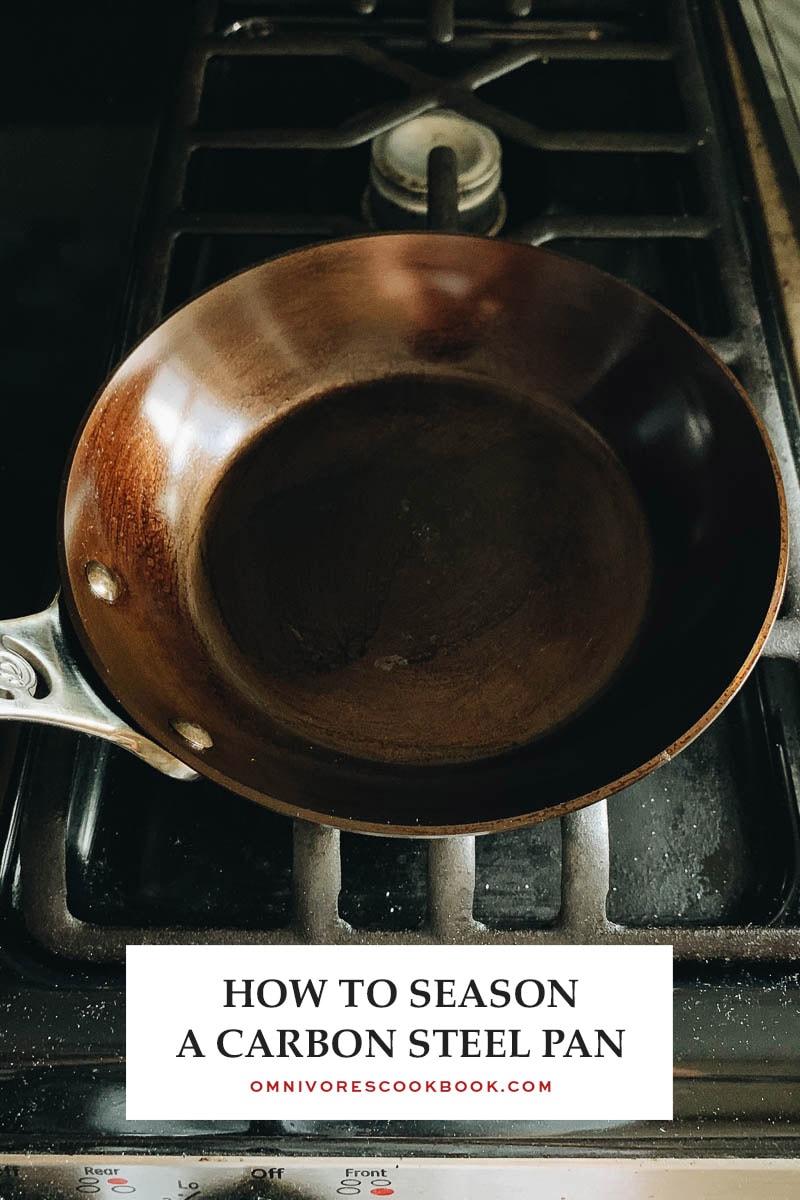
In my last post I laid out the benefits of a carbon steel pan and why I use it daily for Chinese cooking. Now that you’ve got your carbon steel pan, here are the steps you’ll need to take to season your new carbon steel pan before you start cooking with it.
Most carbon steel pans come unseasoned. You can see in the picture below: the new pan on the right has a shiny light grey color, showing the color of the metal that it’s made from. While my well-seasoned pan on the left is almost black.
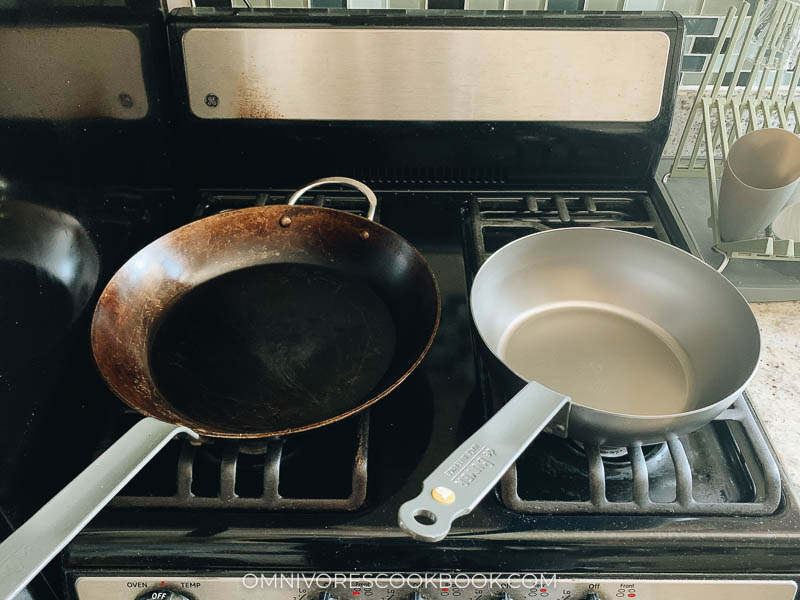
Seasoning a pan is the process of creating epoxide layers on it. This means we use heat to transform thin layers of oil into solid polymer protective coatings that bind to the surface of the pan, which makes the pan nonstick.
Why season your carbon steel pan
- Seasoning creates a barrier between the metal and any water, preventing the pan from rusting
- It gives the pan a nonstick property with a safe and natural process, similar in effectiveness to the teflon coating that a nonstick pan provides.
- Once seasoned, a carbon steel pan will last forever if you take good care of it.
What oil to use
As a general rule, you should use a neutral oil with a medium smoking point.
Types of oil to use
Corn oil, vegetable oil, grapeseed oil, sunflower oil, canola oil
Oils to avoid
Butter, peanut oil, shortening, lard, avocado oil, olive oil, and flaxseed oil
Basically you want to avoid any oil that has a distinct taste and any oil with a high smoking point. There are many articles that recommend flaxseed oil, but a recent report indicates that it’s prone to flake off.
I’ve used various types of oil to season my pans and I’ve never noticed a significant difference. Simply use the neutral oil you have on hand.
How to season a new carbon steel pan
Remove the protective layer & dry it
New, unseasoned carbon steel pans come with a protective layer to prevent them from rusting. You can tell your pan is unseasoned if it has a silver metal color, instead of a pitch black hue. My pan had a coat of beeswax applied to it in the factory, and other pans might use different technology for protection prior to use.
When you purchase a new pan, check the instructions that came with the pan to see how to remove the coating. Usually you can run the pan under hot water and scrub off the coating using a sponge and some dish soap.
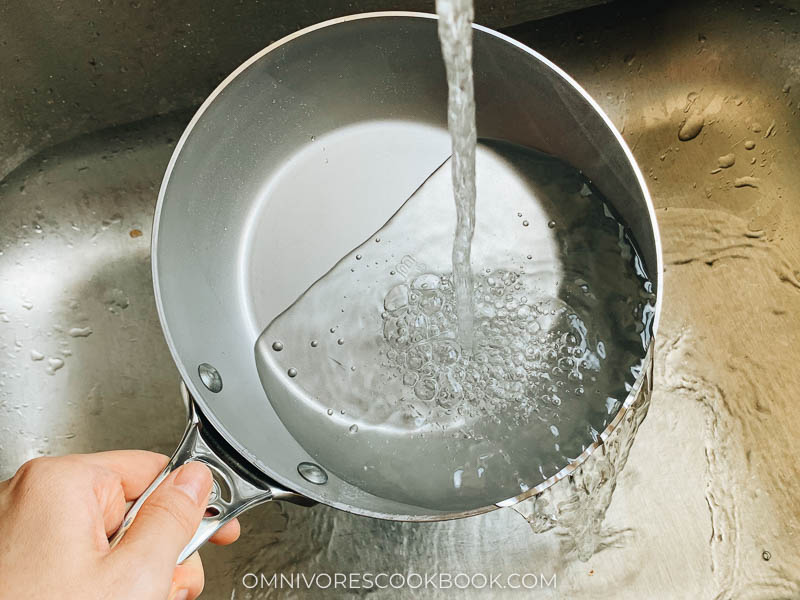
Once you’ve thoroughly cleaned the pan, immediately dry it with paper towels and heat it for a couple of minutes on your stove until bone dry. This step is crucial to prevent your new pan from rusting.
Season the carbon steel pan
Seasoning a new carbon steel pan is actually easier than you think. Here is how:
- Before starting, open the window/door and turn on the ventilation, whichever helps with airflow.
- Drip a few drops of oil onto a few layers of folded paper towels. Wipe the pan thoroughly, so a very thin layer of oil coats the entire inside surface of the pan.

PS. It’s very important that the oil that coats your pan is super thin to ensure even seasoning. You should wipe off any excess oil if you accidentally add too much oil to your pan. It will produce a sticky uneven surface that will require cleanup later.
- Heat up your pan on the stovetop over medium-high heat until it starts to smoke. Continue heating the pan until you see a golden brown color start to appear. If you’re seasoning a large pan, you might see the surface form an uneven color. Move the pan around your stove so it will color evenly.
PS. Be careful not to burn your hands! The pan will become very hot during the process. You can use a pair of tongs to hold a few layers of paper towels to rub on the oil.
- Repeat the whole process a few times so the color of the pan turns darker. I usually repeat the process 3 to 4 times, until the surface turns to a dark brown. I will then use the pan for cooking to naturally build up the patina. If you want the pan to be non-stick as soon as possible, you can repeat the process even more times so the inside of the pan will become almost black.
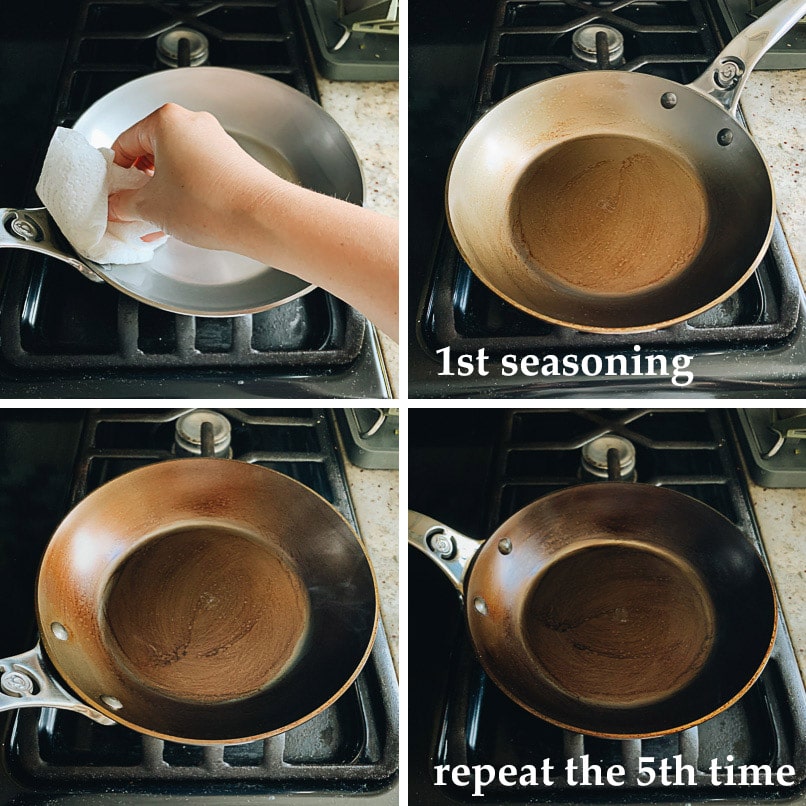
NOTES
- Some tutorials suggest wiping oil on the outside of the pan, as well. I find it unnecessary. I usually do not wash the wax coating from the exterior of the pan, as it will protect the pan well over time.
- It’s very important to wipe out the excess oil from the pan before heating it up. Otherwise the pan won’t season evenly, and even worse, the oil will form bumps caused by half-oxidized oil particles.
- If you’re using a taller pan (such as the Debuyer Country Chef pan, which is similar to a wok), the walls of the pan won’t become very dark unless you heat the sides directly over the flame. However I found that unnecessary. I usually let the walls season naturally over time by simply using the pan for stir-frying.
- Do NOT use the oven-baking method that’s suggested by some instructions. It produces so much smoke and the process is slower. It also melts the coating from the handle if you’re using a Debuyer-branded pan.
That’s it!
Now your new pan is ready and you can start cooking!
Pan performance immediately after seasoning
I fried an egg immediately after I seasoned my pan. The pan was still very hot, so I drizzled about 2 teaspoons of oil into it and cracked the egg on top. I let the egg cook without touching it until the bottom crisped up (very important, otherwise the egg might stick).
I had to use a spatula to gently scrape the edges of the egg, but you can see that the egg came off clear without sticking to the pan.
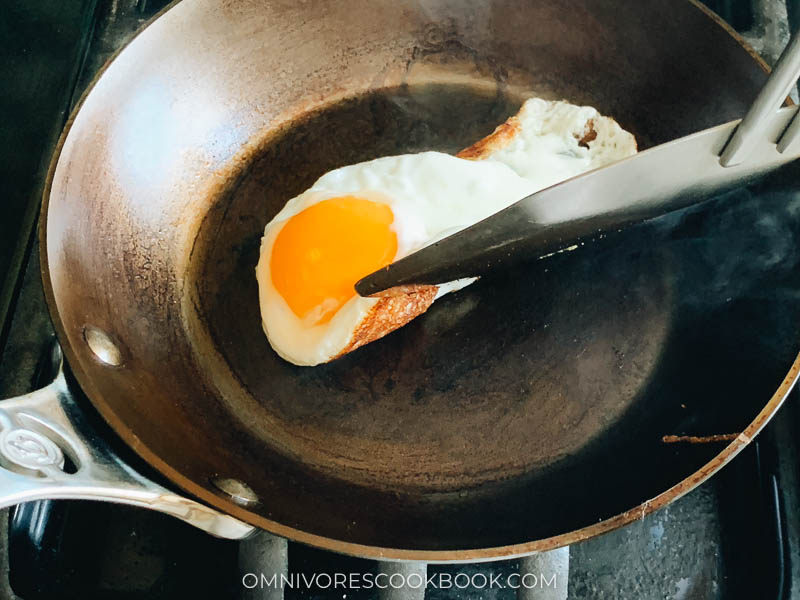
Different from a nonstick pan, the oil is fully absorbed by the pan and it will turn the pan darker (further seasoning). You can expect this until the pan is well seasoned. So be sure to use a bit more oil in your dish if your pan is newly seasoned.
What’s next
Once you’ve seasoned your new pan, it’s important to take good care of it so it will last forever. In the next post, I will introduce how to wash, store, and cook with your carbon steel pan. Stay tuned!
Want to learn more about Chinese Cooking? Sign up my newsletter to receive the 5-Day Chinese Cooking Crash Course and recipe update!













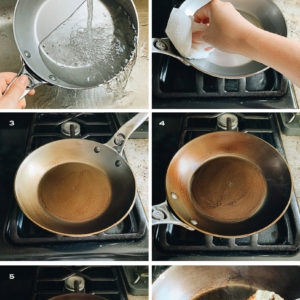
Wonderful demonstration! It seems that most seasoning processes/instructions to demonstrate or assume an open/gas flame stove burner. It seemed to me with a flat top stove it doesn’t heat up the sides as well? Suggestions? What an I doing wrong in that case?
I’ve used electric stove to season my pan before and it worked alright. The sides won’t heat up and season evenly but it’s usually OK (they don’t heat up well on gas stove either). I would just use the pan in cooking to let the sides season naturally overtime.
Alternatively you can use the oven method if you want a more even seasoning (I don’t like it because it creates so much smoke, takes longer, and it’s tricky to handle when the pan gets so hot throughout and you want to apply another layer of oil). For oven seasoning, you need to make sure the pan you bought is ovenproof. Debuyer has two lines – the Mineral B has coated handle that cannot be seasoned in the oven. Their Mineral Pro series can be seasoned and used in the oven.
i tried to enter contest but my computer would not go to instagram. network problem? anyway i tried to get a ticket. good articles. still looking for simple sauce for general stir fry. thanks. congrats on anniversary. my mother often reminded us of our anniversary. sure do miss her.
Hi Maggie,
Your post is the most detailed I’ve seen so far!! Thank you for this post. Most blogs say “seasoning is so easy” but I’ve messed up so many times on my carbon steel and cast iron pans, I’ve virtually given up – but after this post I feel inspired to try again!
So – what if you screw up the seasoning on your carbon steel pan – how do you start over?
1 – I used too much oil so now there is a sticky residue on the pan, as you said! Can I scratch this off with a steel wool pad to rub the sticky oil layer off?
2 – I put it in the oven (followed the oven instructions) now the handle / logo is melted – assume there is no fix for this
Thank you again!!!
Hi Christine, thanks for the kind words! Same here, I’ve seasoned several cast iron and carbon steel pans in the past using random tutorial, most of them didn’t come out right at all. (In fact, when I grew up in China, my mom would use professional seasoning service when we buy a cast iron wok, and I never did it at home and didn’t know how).
To answer your questions, yes, you can totally scrub off the the sticky oil layer. Once done, your pan need to be re-seasoned again. However, once you’ve seasoned the pan properly and it has become darker, you might come across small sticky oil patches in the future during cooking (it’s caused by cooking oil in your dish). I wouldn’t worry too much in this case because most of the time you can make it disappear by deglaze the pan (pour in some stock/water/wine when the pan is hot and scrape off the brown bits using a wooden spatula). When you use the pan even longer and it turns black completely, you can even gently scrub the pan with a tiny bit of detergent if it needs a deep clean, and the seasoning shouldn’t come off too much.
About the melted logo – you’re right, there’s no fix for that. One of my pans has melted handle too and I just need to live with it.
This is partially accurate. The oven method works very well. Less smoke. You should definitely season the outside of your pan as well to protect it.
When I am doing 3-4 seasonings should I wait until the pan cools to do another seasoning or do it right away when it it hot.
You can do it right away when it’s hot.
Best seasoning and care explanation I”ve seen. I won’t be using the flax seed oil I got. I would like advice on recipes. I’ve a vegetarian and don’t cook meat but would like information on how to use tofu, or other substitutes. I’d also like recipes for vegetable dishes that would constitute a complete meal. I loved the directiveness of your comments. Just seemed like a really strong mind. Picture seemed to indicate a strong back as well to tote all that camera gear.
I’ve been using my wok for over a year before knowing it had to be seasoned. what should I do?
If your food doesn’t stick to the wok then it’s totally fine just to keep using it.
Depending one the store and the brand, some of the woks might come seasoned when you bought them. When you cook with them, the oil will react when heating with high heat and it keeps seasons the surface so it will perform better and better over time. If the surface of your pan is in a dark brown or near black instead of a light silver, you’re in the clear.
Hi Maggie. Thanks for detailed instruction. However, my wife let my pan air dry. Now, it’s got rust on the inside. Is my pan ruined or can I rescue it? If so, what’s the best way to get the rust out?
Air dry is gonna cause issue because the water won’t be able to dry fast and it will cause rust.
If there’s not too much rust, you can try add coarse salt and oil to the pan, then scrub with paper towels. If it doesn’t come off, you can also try using steel wool. Once the rust comes off, you need to re-season the pan before using.
I recommend use paper towels or dish towels to dry the pan completely. You can heat it up on stove again just to make sure the moist is gone completely.
You said “the oil is fully absorbed by the pan and it will turn the pan darker” and I would say that is pretty much impossible. The oil just burned off combined with the food absorbing some of it.